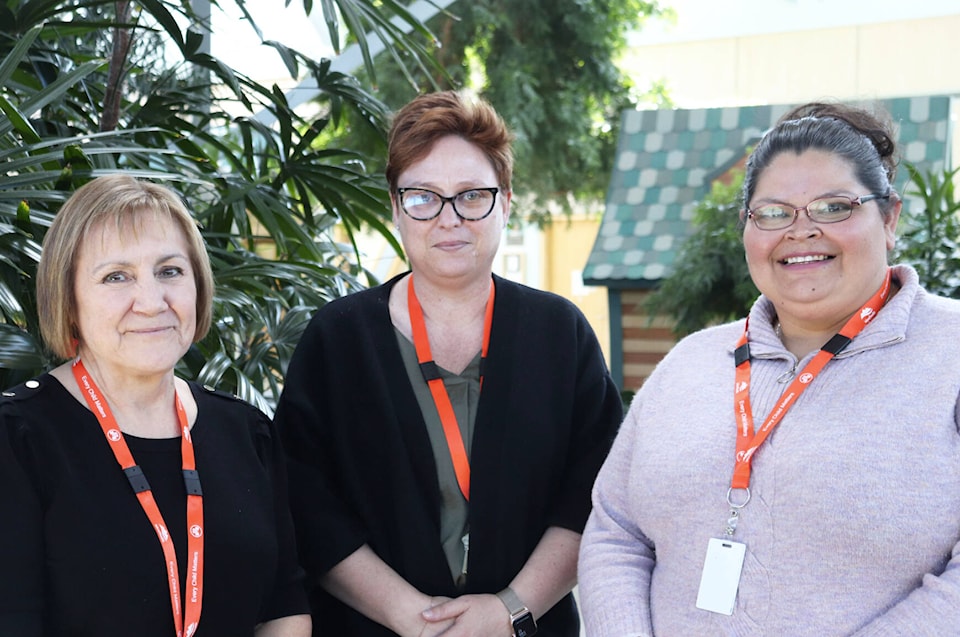By Alexandra Mehl, Local Journalism Initiative Reporter HA-SHILTH-SA
Amanda Watts of Tseshaht and Deb Melvin of the Metlakatla First Nation have a varied day-to-day schedule at the West Coast General Hospital, but it’s always centered on ensuring their Indigenous patients feel safe and get the care they need.
As an Indigenous patient navigator (IPN) Melvin is busy answering phone calls from her patients, nurses and doctors, organizing and advocating for their care, planning for their discharge or transportation, all while supporting not only the patient, but their family, as they navigate the health care system.
Though Melvin is a new employee of Island Health, she’s been working in her position at WCGH, employed by Nuu-chah-nulth Tribal Council, for five years.
Watts, who is an Indigenous liaison nurse (ILN), supports patients in the Emergency Room, ensuring those coming to WCGH have what they need. She sits with them, listens to them, and builds connections, sometimes becoming a point of communication between the patient and the doctor. Given notice, she’ll even meet her patients as they enter the facility.
The team of two are there to walk beside their patients on their journey through the healthcare system, advocating for and helping empower them.
“It’s important for people to know that we’re here,” said Watts, who began the new IPN position in February. “I’m very passionate about supporting my people.”
“I’m here, I’m working here, but I’m here for you,” she noted.
Given Canada’s colonial history of residential schools and segregated Indian hospitals, there are many gaps for First Nations in the health care system.
“We have to understand the legacy of the Indian hospital in this province,” reads a quote from an unidentified health care provider in the In-Plain-Sight survey, a provincial review of Indigenous racism in the healthcare system. “Still to this day, I have people in communities who tell me they do not want to go to the hospital for care because that is where their grandparents died under atrocious conditions.”
“If hospital administrators don’t understand that, how can we provide care? If they just say, `Oh, they’re non-compliant. They don’t show up for appointments.’ Well, yeah. Do you know why?” the health care provider continued.
For those patients who have been affected by residential school and its intergenerational trauma, it may be lonely, scary, or raise feelings of anxiety going into a hospital setting, shared Melvin.
“A lot of people don’t come to the hospital willingly, or… a lot of them have had previous bad experiences here and don’t want to return,” she said. “So it’s great to be able to support people through their visits, and make it a more comfortable and safe experience.”
“The doctors and nurses can be seen as in control, and that does make the patient feel a loss of control or no power in the interactions,” continued Melvin. “And unfortunately, some of them have not been respected or treated well in the past, and don’t want to come back.”
According to the In-Plain-Sight survey, just 27 per cent of Indigenous respondents felt their needs were taken care of when accessing health care, compared to 59 per cent of non-Indigenous patients.
Fifty-eight per cent of non-Indigenous respondents received the medication they asked for, compared to that of 35 per cent of Indigenous respondents.
“The Indigenous population has, unfortunately, had poor healthcare outcomes for so long,” said Melvin. “We want to change that, it’s not right.”
“We want to be there for people to support them, to want to reach out, to want to try and come to the hospital, to not, maybe, delay as long as some people do,” Melvin noted.
Watts reflects on phone calls she received where a local service provider was bringing an apprehensive patient to the hospital. When they arrived at WCGH, Watts greeted them and sat with them at triage, offering whatever the patient may need.
She shared another instance where a young patient was upset and crying. Watts brought toys to cheer the child up. From then on, each time the patient saw Watts, the patient proudly showed off the toys, playing with them through the entire stay.
“If we can do anything to make someone’s experience one per cent better, then that is excellent,” said Jess McConnell, manager of Indigenous Health at WCGH.
“We want to relieve their anxiety, to support them, make them feel safe, make them feel welcome, and cared for and respected,” said Melvin.
IPN and ILN can be accessed at nearly every hospital on Vancouver Island, McConnell noted.
“We’re here for you,” said Melvin. “Contact us.”
READ ALSO: Anti-Indigenous racism embedded in B.C. healthcare system: report
READ ALSO: Indigenous patients face higher risk of death post-surgery, study suggests



